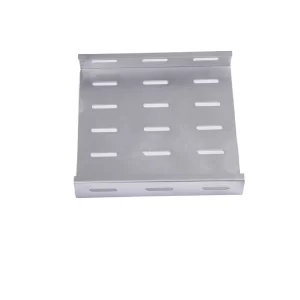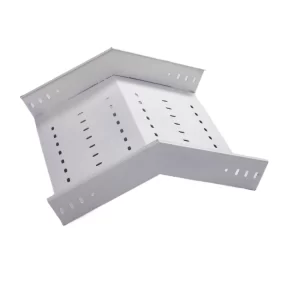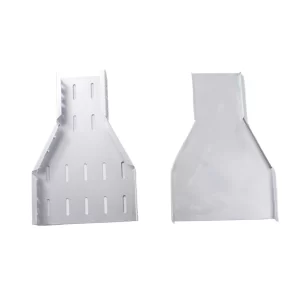In the realm of cable management systems, two common options that often come up are perforated cable trays and channel cable trays. Both play crucial roles in organizing and protecting electrical cables, but they have distinct characteristics that set them apart. Understanding these differences is essential for making informed decisions when it comes to choosing the right cable tray for a particular application.
Cable trays are an integral part of electrical installations, providing a structured and efficient way to route and support cables. They not only help in keeping cables organized but also protect them from damage and facilitate easy maintenance and troubleshooting. Perforated cable trays and channel cable trays are two popular types, each with its own set of advantages and disadvantages.

Perforated Cable Tray
1. Design and Construction
Perforated cable trays are typically made of metal, such as steel or aluminum. The tray surface is punctured with a series of small holes or perforations.
These perforations are evenly distributed across the tray, allowing for air circulation and ventilation around the cables. This is particularly important in applications where heat dissipation is a concern, as it helps to prevent overheating of the cables.
The perforated design also reduces the weight of the tray compared to solid trays, making it easier to handle and install.
2. Cable Management Features
The perforations in the tray provide multiple points for cable ties or clips to secure the cables in place. This allows for easy organization and routing of cables, ensuring that they are neatly arranged and not tangled.
Perforated cable trays are available in various sizes and configurations, allowing for flexibility in accommodating different cable sizes and quantities. They can be used in both horizontal and vertical installations, providing versatility in cable routing.
The open design of perforated trays makes it easy to access and inspect the cables, facilitating maintenance and troubleshooting.
3. Advantages
Good ventilation: The perforations promote air circulation, reducing the risk of heat buildup and prolonging the lifespan of the cables.
Lightweight: The reduced weight makes installation quicker and less labor-intensive.
Easy cable management: The perforations allow for easy attachment of cable ties or clips, facilitating neat cable routing.
Cost-effective: Perforated cable trays are often more affordable than some other types of cable trays.
4. Disadvantages
Limited load capacity: Due to the perforations, perforated cable trays may have a lower load capacity compared to solid trays. This can be a consideration when dealing with heavy cables or large numbers of cables.
Less protection: The open design provides less protection against physical damage and environmental factors compared to channel cable trays. In some cases, additional protection measures may be required.

Channel Cable Tray
1. Design and Construction
Channel cable trays, also known as trough cable trays, are usually made of metal or plastic. They have a U-shaped or trough-like design with a solid bottom and sides.
The solid construction provides a more enclosed environment for the cables, offering better protection against physical damage, dust, moisture, and other environmental factors.
Channel cable trays come in different sizes and depths to accommodate various cable sizes and quantities.
2. Cable Management Features
Cables can be laid directly in the channel or secured using cable clips or brackets. The solid sides and bottom help to contain the cables and prevent them from falling out or getting displaced.
Channel cable trays are often used in applications where cable protection is a priority, such as in industrial environments, outdoor installations, or areas with high levels of dust or moisture.
Some channel cable trays may have covers or lids that can be added for additional protection and security.
3. Advantages
Enhanced protection: The solid construction provides better protection against physical damage and environmental factors.
Higher load capacity: Channel cable trays generally have a higher load capacity compared to perforated trays, making them suitable for heavy cables or large cable bundles.
Stable installation: The solid sides and bottom provide a more stable platform for cable routing, reducing the risk of cable movement or sagging.
4. Disadvantages
Reduced ventilation: The enclosed design may limit air circulation around the cables, potentially leading to heat buildup. In some cases, additional ventilation measures may be required.
Heavier weight: The solid construction makes channel cable trays heavier than perforated trays, which can make installation more challenging and require more labor.
Less flexibility: The enclosed design may be less flexible in terms of cable routing compared to perforated trays.

Comparison in Different Aspects
1. Ventilation
Perforated cable trays offer excellent ventilation due to their open design with perforations. This helps in dissipating heat generated by the cables, making them ideal for applications where heat management is crucial.
Channel cable trays, on the other hand, have limited ventilation due to their enclosed design. This can be a disadvantage in applications where heat buildup is a concern, as additional measures may be needed to ensure proper ventilation.
2. Cable Protection
Channel cable trays provide superior protection against physical damage, dust, moisture, and other environmental factors. The solid construction acts as a shield for the cables, reducing the risk of damage.
Perforated cable trays offer less protection in this regard, as the open design leaves the cables more exposed. However, in some cases, additional protection can be added to perforated trays, such as using cable sleeves or conduit.
3. Load Capacity
Channel cable trays typically have a higher load capacity than perforated cable trays. This is due to their solid construction and stronger design, which can handle heavier cables and larger cable bundles.
Perforated cable trays may be suitable for lighter loads or applications where weight is a concern. However, it’s important to consider the load requirements when choosing a cable tray.
4. Installation and Flexibility
Perforated cable trays are generally easier to install due to their lighter weight and open design. They can be quickly assembled and adjusted during installation, providing more flexibility in cable routing.
Channel cable trays may be more challenging to install due to their heavier weight and enclosed design. They may require more labor and specialized tools for installation. However, once installed, they provide a more stable and secure cable routing solution.
5. Cost
Perforated cable trays are often more cost-effective than channel cable trays. The simpler design and lighter weight contribute to lower manufacturing costs, making them a more affordable option.
Channel cable trays may be more expensive due to their solid construction and additional features for cable protection. However, the cost difference may be justified in applications where enhanced protection and higher load capacity are required.
In conclusion, perforated cable trays and channel cable trays each have their own unique characteristics and advantages. The choice between the two depends on various factors such as the application requirements, cable protection needs, load capacity, ventilation requirements, installation ease, and cost. By understanding these differences, you can make an informed decision and select the cable tray that best suits your specific needs. Whether it’s the ventilation and lightweight nature of perforated trays or the enhanced protection and higher load capacity of channel cable trays, both options play an important role in effective cable management.
